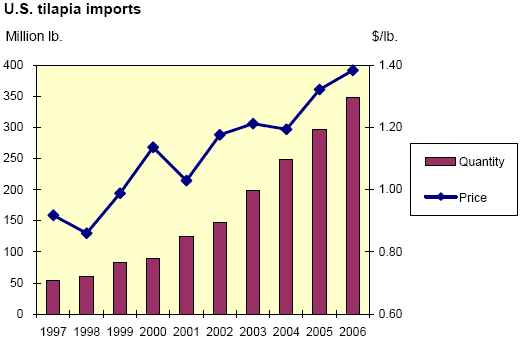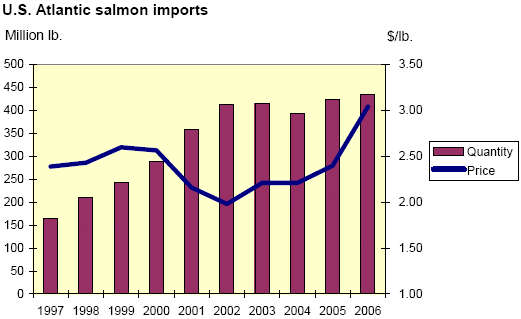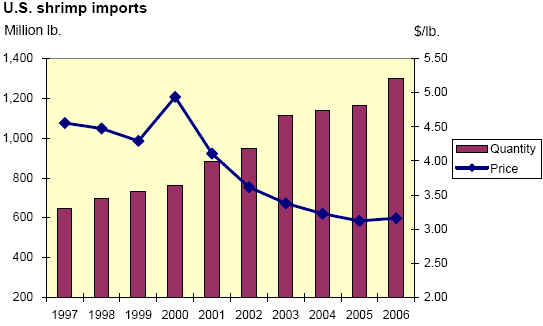Aquaculture
Imports of tilapia, Atlantic salmon, and shrimp all rose in 2006. Together, U.S. imports of these three species accounted for $5.9 billion in 2006, which is likely to be between 40 and 45 percent of the total value of all edible fish imports. Imports of these three species are discussed because they are species for which a significant portion of the shipments to the United States are from aquaculture production.
Growth in Seafood Imports from Aquaculture
Over the last decade, farm-raised seafood products have grown from a relatively small portion of total U.S. seafood imports to become the dominant source of certain seafood products. Much of this growth has been driven by the continuing increase in the percentage of total U.S. seafood consumed away from home. Due to this linkage to the away-from-home food market, the demand for many imported seafood products is tied to the state of the U.S. economy. Other factors influencing the demand for imported seafood are the strength of the U.S. dollar relative to other currencies and prices of competing protein products, such as beef, pork, and poultry.
Most aquaculture imports are expected to face an expanding market in 2007. First, the U.S. economy is forecast to remain strong in 2007. Second, prices for many competing protein products are forecast to generally be higher. Partially offsetting these expansionary market factors is the forecast relative weakness of the U.S. dollar against a number of other currencies. However, since aquaculture products come from a large number of countries, this will not have a negative impact in all cases.
Imports of tilapia, Atlantic salmon, and shrimp are tracked in relation to the domestic aquaculture industry because these three species are among the most valuable seafood imports and they are all species for which a significant portion of the imports are farm-raised products. In 2006, the import value for these three items was approximately $5.9 billion, which will likely to represent about 40 percent to 45 percent of all edible seafood imports.
Tilapia Imports Rose by 17 Percent in 2006
U.S. tilapia imports surged to over 349 million pounds in 2006, up 17 percent from 2005 and 291 percent from 2000. The value of tilapia imports rose even faster, climbing to $483 million in 2006, 23 percent above the previous year and 376 percent higher than in 2000. Tilapia imports, which were relatively small only 10 years ago, are now on par, in value, with U.S. exports of fresh and frozen salmon, which are among the largest export products of the U.S. fishing industry. In 2005, the National Marine Fisheries Service reported that U.S. exports of fresh and frozen salmon totaled 294 million pounds, with a value of $416 million. Tilapia is a mildtasting fish, most often sold as a filleted product in grocery stores, but also as a featured dish in many mid-priced restaurants. There is also a market for whole tilapia at ethnic grocery stores.
Growth in shipments to the United States in 2006 came in all three of the tilapia import categories (frozen whole, fresh filleted, and frozen filleted), but as in previous years the majority of the increase was due to higher imports of frozen tilapia fillets. Since 2000, tilapia imports have grown by 260 million pounds, with 59 percent of that increase coming from higher imports of filleted products. Imports of frozen whole fish had been the largest import category in terms of quantity, but since 2000 imports in this category have risen at a much slower rate than filleted products.

Source: Bureau of the Census, Dept. of Commerce.
Since filleted products account for only a small percentage of a fish’s total weight, the 349 million pounds of tilapia exported to the United States required approximately 775 to 800 million pounds of fish on a live-weight basis.
In the last several years, frozen fillets have become the largest segment of tilapia imports. In 2006, the quantity of frozen fillets imported rose by 34 percent and represented just over 50 percent of all tilapia imports by value. Since most of the frozen fillets are imported from Asian producers, this has added to the already large amount of seafood products coming from Asia, especially China. In 2006, China supplied 66 percent of all tilapia products imported into the United States, and China is the largest supplier of both frozen whole tilapia and frozen tilapia fillets. Since 2000, shipments of frozen tilapia fillets from China have risen from 4 million to 140 million pounds. Chinese frozen tilapia fillets averaged $1.38 per pound in 2006, about even with the previous 2 years. U.S. tilapia imports from China are expected to continue to expand in 2007 as the demand for filleted products continues to grow, especially from mid–priced restaurants.
The volume of imported fresh tilapia fillets rose to 51 million pounds in 2006, up only 2 percent from a year earlier. The value of this segment has also been rising, with shipments in 2006 valued at $148 million, up almost $18 million from 2005. Average prices for fresh fillets have been decreasing gradually, but considering the expansion in the amount of product imported, prices have remained relatively strong. Shipments of fresh tilapia fillets from Ecuador have been the fastest growing over the last several years, and in 2006 accounted for 47 percent of the total. Imports of fresh fillets from Honduras and Costa Rica make up most of the remainder. With strong price competition in the shrimp industry, some aquaculture producers in Central and South America may have an incentive to expand tilapia production.
In 2007, tilapia imports are again expected to expand, benefiting from a strong U.S. economy, which, in turn, is expected to increase demand in the foodservice and restaurant markets. The rate of increase in tilapia imports is expected to be tempered by the relative weakness of the U.S. dollar against a number of foreign currencies. Total tilapia imports in 2007 are expected to reach between 375 million and 385 million pounds on a product-weight basis, and over 800 million pounds on a live-weight basis. The value of imports is expected to total $515 million to $525 million. The average import price is not expected to grow as strongly in 2007, as competition among producers is expected to offset the trend for higher average prices due to a higher percentage of filleted tilapia imports.
Atlantic Salmon Imports Reach $1.3 Billion
The value of U.S. imports of Atlantic salmon reached over $1.3 billion in 2006, an increase of over 30 percent from 2005. Since 2000, the value of Atlantic salmon imports has increased by 78 percent. On a quantity basis, imports totaled 435 million pounds in 2006, a 2.8-percent increase from 2005 and up 50 percent from 2000. The average price for all Atlantic salmon imports in 2006 was $3.04 per pound, an increase of 64 cents per pound (27 percent) over the 2005 average. Most of the gain in import quantity was due to higher shipments from Canada, Norway, the UK, and China, which offset a 9-percent decrease in imports from Chile. Along with the higher volumes, there were price increases for all three of the import categories (fresh whole, frozen whole, and fresh and frozen fillets).
The increase in the total quantity of Atlantic salmon imported was due mostly to higher imports of fresh salmon from Canada. Prices for Atlantic salmon imports had been steady over the last 2 years, after falling for several years. In 2006, the increase in fresh salmon from Canada, which normally sells at a premium price, helped boost the average price of fresh products. Even with the U.S. dollar falling compared with the Euro, imports from major European Atlantic salmon producers were up strongly. Overall shipments of Atlantic salmon from Norway were 49 percent higher, and shipments from the United Kingdom rose by 60 percent, compared with the previous year. Overall, Atlantic salmon prices are expected to hold steady or increase slightly in 2007 as a weaker U.S. dollar makes imports more expensive.
After falling in 2003 and 2004, imports of fresh whole Atlantic salmon have risen considerably in the last 2 years (up 17 percent in 2005 and 21 percent in 2006). This increase in fresh salmon imports was the main reason for the overall increase in the quantity of Atlantic salmon imports in 2006; previously, filleted product imports had been the main force behind import growth. In 2006, imports of fresh and frozen filleted products accounted for 59 percent of total Atlantic salmon imports on a quantity basis and 67 percent on a value basis. Although imports from Chile, the largest supplier of filleted products, fell in 2006, the overall price of products from Chile rose by over a dollar per pound to $3.43. While there will continue to be a market for fresh and frozen whole fish at specialized seafood outlets, most future import growth is expected to come from filleted products, due to the demand for partly or fully prepared products for mid-price restaurants and prepared meals at grocery stores.

Source: Bureau of the Census, Dept. of Commerce.
Even with U.S. economic growth in 2007 forecast to be relatively strong, imports of Atlantic salmon in 2007 are not expected to expand as rapidly as in 2006. Shipments in 2007 are expected to be near the 445-to 455-million-pound level, and value is expected to be between $1.3 and $1.4 billion. Higher demand for salmon products due to health and dietary factors is expected to help maintain the price increases of 2006, as are generally higher prices for competing protein sources.
Shrimp Imports: Volume Higher, Prices Rise
The volume of imported shrimp continued to move higher in 2006, reaching just over 1.3 billion pounds, up 12 percent from the previous year. The strong increase in volume, combined with a small increase in average prices, pushed the value of imported shrimp to a record $4.12 billion. Over the previous 5 consecutive years the average price for imported shrimp products declined, falling from $4.94 per pound in 2000 to $3.12 per pound in 2005. In 2006, the average price rose by 4 cents per pound (1.3 percent), boosted by higher prices in the frozen and processed markets.
For the second consecutive year, the bulk of the increase in total shrimp imports was due to larger shipments (up 29 percent) of processed shrimp products. Frozen shrimp imports rose by 6 percent and fresh imports were up 35 percent, but they account for only a small fraction of total shrimp imports. In terms of value, fresh and processed shrimp prices were higher in 2006. The average price for frozen shrimp imports rose by 1.2 percent to $3.25 per pound, and the average price for imported processed shrimp products rose to $2.90 per pound, an increase of 3.6 percent.

Source: Bureau of the Census, Dept. of Commerce.
Of the eight largest exporters of shrimp to the United States in 2006, six countries showed strong volume increases that helped offset declines in shipments from India and Vietnam. Although it is hard to measure the impact of tariffs that have been placed on frozen shrimp imports from a number of countries, several of those countries, such as India and Vietnam, decreased their shipments in 2006. The tariffs are only on frozen shrimp imports, which may have helped to boost the shipments of processed shrimp products.
A significant change in U.S. imports in the previous 3 years has been the rise of Indonesia as a major supplier and the decline of China. Between 2003 and 2005, imports from Indonesia grew from less than 50 million pounds to over 116 million, partly the result of a more stable business environment in that country. In 2006 shipments from Indonesia rose an additional 12 percent to 129.5 million pounds. In 2003, imports from China totaled 179 million pounds, but had declined to less than 100 million pounds in 2005. This decrease was driven by falling shipments of frozen shrimp, as shipments of prepared shrimp products rose by 34 million pounds during the 2003 to 2005 period. This decline was partially reversed in 2006, with shipments from China totaling 150 million pounds, up 51 million (52 percent) from 2005.
During 2007, a number of factors are expected to influence U.S. shrimp imports. First, with the dollar weak compared with a number of other currencies, other markets may be more attractive to shrimp exporters. Second, one of the factors fueling growth in U.S. shrimp imports was the large decrease in average prices over the last several years. If prices hold steady, growth in the quantity of shrimp imported may be reduced. Third, partially offsetting the first two factors is the forecast for a strong increase in U.S. disposable personal income. This should have a positive impact on the demand for relatively high-priced food items like shrimp.
In 2007, shrimp imports are expected to again increase, but at a slower rate than in 2006. The demand for imported shrimp is expected to be pushed by the forecast for a generally strong domestic economy, which should translate to higher sales through food service and restaurants. Average prices for shrimp are expected to rise only slightly in 2007, as higher demand is offset by strong competition in the worldwide shrimp industry.
Further Information
For more information view the full Livestock, Dairy and Poultry Outlook - April 2007 (pdf)
April 2007

